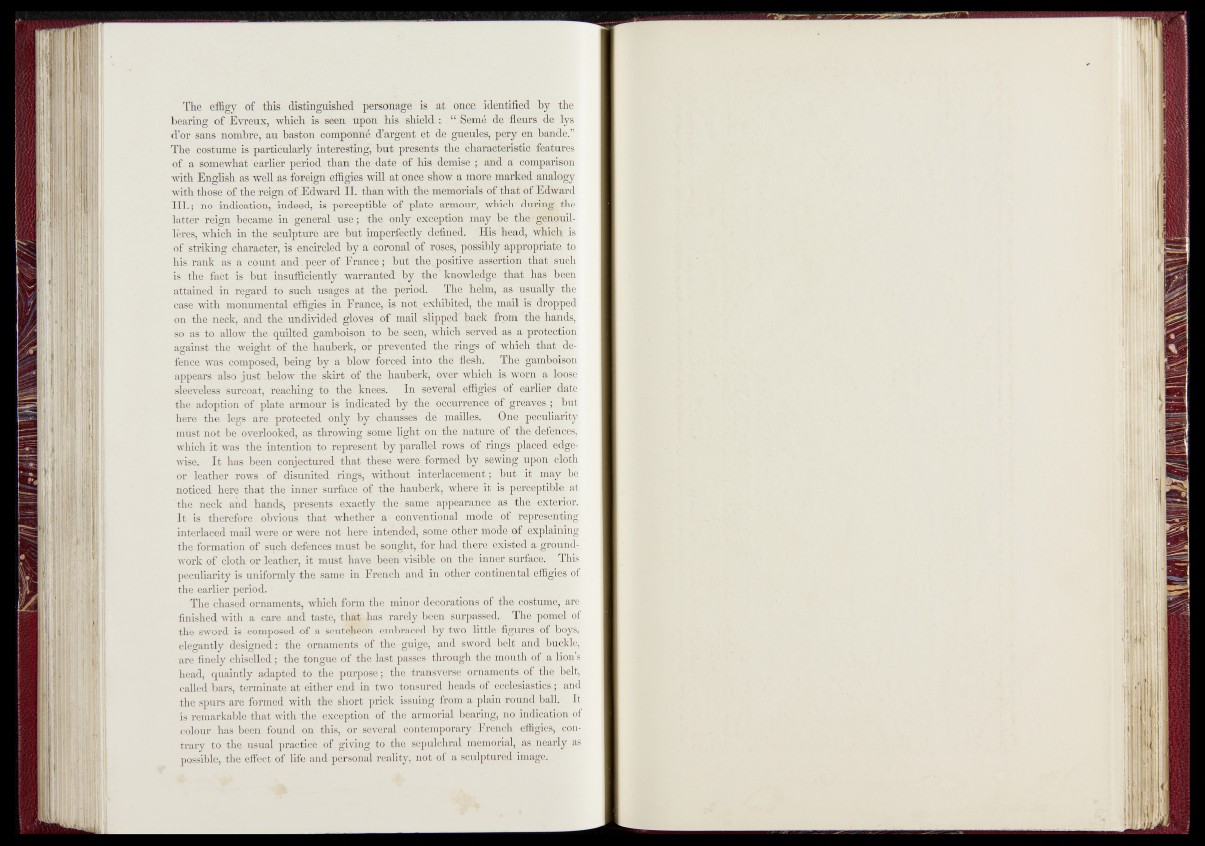
TV effigy rtf thk distimgTnshfid personage > is " at once. idérrtçftM*';-by |jie
bearing of Evreux, which, is, seen upon Ids shield.: .'fSemë. .de fleurs de p
d’or sans notohfe^an baston componné d’argent et de gueules, pery eûHtëjktde."
The costume: is-particularly. interesfeg/büf presents- th§ characteristic féâti^es
of a. somewhat [earlier period,-than- the'date of his demise / and' «f cdihpaiison
with English as well as foreign effigies will at pace show a more marked analogy
with those of the-reign. ©fcEdwâfd II. than with the memorials of that of Edward
I I I ; no indication, indeed, is,perceptible of-plate aimonr, which during pie
latter reign became.iin ‘general .use ; tf e only exception may ^ y th g ^ ^ P u il-
lèrês,. which in the sculpture are but impèHectly défmêdr f His/head, wjuçli is
of striking character, 'is.nncmcled by a coronal of rpses^possiblyjappropriafe to
his .rank as a count and .-peer, of France ; but the mositiv.e .assertion
is ..the ..fact'is 'hut mSufficiööt^' warranted'-,by the^knowledge ubk haÿl^en
attained.-in regard to such usages■ at | thevppiiöd'. .The hppnj las u g lily jphe
case »with monumental, effiles in France, is'^ot^e^bibited^ the^stE^^^^pped
On the neck,, and the. undivided'gloves o f maiï^shppeuTback |ipm?*'|^^|ands,
§& as, ta-allow the quilted gamboison tto he geen, which served as a ion
rfgfeMwfcJq p l weight of iftelhaiiberk, or prevented i/fc^e rjngs ''ofv^^K^ÖLaftjK-
fenee iras Composed, being by a blow ^>rce"di .the flesh;
appears also fast .below the skirt of the hauberk, ov.ef^Hétf ia ^ o rn -^ ^B e
sleeveless surcoat, reaching to the knees. In several - effigies*.'of eârli^^fete
the adoption ;of- plate armour is indicated btithel nchflrrence: - of ittavei:.;. Bpt
here the legs are protected only by chausses' .dgl-mailles.
“must not è a overlooked, as throwing some light om jStf.naljire’
which it was- the intention to represent by parallel ^ows"bfÿ^^_place|è#ge-
wise. It has been conjectured that these were, formed.îj^Vjewing upo^^Mth
o f leather rows .of disunited rings, without ^inferlacement;;1 ;bptT
noticed hère that the inner surface p fjh e hauberk,' where .it at
the neck and hands, presents exactly H$ié' same"* apgeargnce as gxterior.
It is therefore. obvious that whether -^''‘Cony^tijpï^^jP^^^'Êppféseiïting
interlaced mail were or were not here intended, some/pt^ÿ^^deof ^e^pl^ning
the formation of such defences must bel sought,' for had there, existed a groundwork
.of cloth or leather, it must have been visible on/the tinner suiïaceî ' pThis
peculiarity is uniformly the same in French and in 'other continental-efiigies of
the earlier, period. 5
; The chased ornaments, which forinthe, minor decorations offhe cpstume, are
finished with à care and taste, thatdias rarely been surpassed. The pomel of
the. sword- is composed of a scutjtëön embraced by two. little figures of boys,
elegantly designed f the ornaments of the • guige, and sword-belt and-buckle,
are, finely .chiselled ; the tongue'of the last passes throûgh the. mouth of. a lion’s
head,- «pminfly adapted/ta the purpose.;', the transverse ornaments of th ep ||t,
called bars, terminate at either énd-in two tonsured .heads of ecclesiastics. ; and
the spurs are formed with the. short prick issuing ,from a plain r°upd'ball. . It
is remarkable that with the exception of the armorial bearing, no indication of
.colour .his been, found on- this,, or several, contemporary: French effigies,
trary to, the usual practice..of.giving to,.the sepulchral memorial, as,nearly as
possible, the effect öf fife and personal reality, not of a sculptured image..